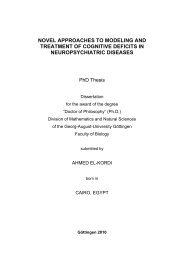Cortical and subcortical mechanisms in persistent stuttering ...
Cortical and subcortical mechanisms in persistent stuttering ...
Cortical and subcortical mechanisms in persistent stuttering ...
You also want an ePaper? Increase the reach of your titles
YUMPU automatically turns print PDFs into web optimized ePapers that Google loves.
Chapter 1 Introduction<br />
Genetic susceptibility<br />
Stutter<strong>in</strong>g has been long recognized to have a genetic component (Suresh et al., 2006). Family<br />
cluster<strong>in</strong>g is frequently reported, several tw<strong>in</strong> studies document a high degree of heritability<br />
<strong>and</strong> male relatives of female stutterers are at greater risk to develop stutter<strong>in</strong>g; an excellent<br />
overview is given by Yairi <strong>and</strong> Ambrose (2005). The role of genetic contributions <strong>in</strong> the<br />
aetiology of stutter<strong>in</strong>g is complex, multifactorial, <strong>and</strong> heterogeneous (Fisher, 2010). Geneticl<strong>in</strong>kage<br />
studies yielded suggestive evidence of l<strong>in</strong>kage at multiple chromosomal sites with<br />
little overlap among <strong>in</strong>dependent data sets (Kang et al., 2010). One example of suggestive<br />
l<strong>in</strong>kage has its locus on chromosome 12q <strong>and</strong> was found <strong>in</strong> a study which <strong>in</strong>cluded<br />
consangu<strong>in</strong>eous families <strong>in</strong> Pakistan (Riaz et al., 2005). A cont<strong>in</strong>uative analysis of<br />
chromosome 12q23.3 genomic region <strong>in</strong> consangu<strong>in</strong>eous Pakistani families revealed genetic<br />
abnormalities <strong>in</strong> the lysosomal enzyme–target<strong>in</strong>g pathway (Kang et al., 2010).<br />
1.4 Approaches to expla<strong>in</strong> stutter<strong>in</strong>g<br />
The phenomenon of stutter<strong>in</strong>g gave rise to manifold theories, each shaped by the perspective<br />
of a certa<strong>in</strong> field such as for example analytic psychology (Damste et al., 1968), speech <strong>and</strong><br />
language pathology e.g. (Bloodste<strong>in</strong> <strong>and</strong> Ratner, 2008; Van Riper, 1971; Yairi <strong>and</strong> Ambrose,<br />
2005), psychology e.g. (Smith <strong>and</strong> Kelly, 1997; Starkweather <strong>and</strong> Gottwald, 1990), l<strong>in</strong>guistics<br />
e.g. (Coulter et al., 2009; Howell, 2004; Postma <strong>and</strong> Kolk, 1993), biomechanics e.g. (Civier et<br />
al., 2010; Namasivayam et al., 2009; Van Lieshout, 2004) <strong>and</strong> neuroscience e.g. (Alm, 2004;<br />
Brown et al., 2005; Büchel <strong>and</strong> Sommer, 2004; Kell et al., 2009; Ludlow, 2000). This<br />
multiplicity of approaches is plausible due to the fact that a broad assortment of l<strong>in</strong>guistic,<br />
cognitive, <strong>and</strong> sensorimotor processes is <strong>in</strong>volved <strong>in</strong> speech production.<br />
We focus on stutter<strong>in</strong>g as a motor disorder. Before I detail this speech motor control<br />
perspective I briefly mention the psychol<strong>in</strong>guistic perspective, not only because it has strongly<br />
<strong>in</strong>fluenced stutter<strong>in</strong>g research but also because this perspective was considered <strong>in</strong> the third<br />
study (phoneme identification) <strong>in</strong>cluded <strong>in</strong> this dissertation. An awareness of the diverse<br />
approaches to problems <strong>in</strong> stutter<strong>in</strong>g is important, because a certa<strong>in</strong> experimental result may<br />
be given disparate <strong>in</strong>terpretations by different <strong>in</strong>vestigators.<br />
1.4.1 Psychol<strong>in</strong>guistic approach<br />
It is still a matter of debate, whether stutter<strong>in</strong>g is a language disorder or a motor control<br />
disorder (Kent, 2000). The challenge <strong>in</strong> underst<strong>and</strong><strong>in</strong>g stutter<strong>in</strong>g is the dist<strong>in</strong>ction between<br />
impairments of the language system <strong>and</strong> impairments of motor control per se (Kent, 2000).<br />
Several attempts to expla<strong>in</strong> stutter<strong>in</strong>g favor the fluency failure result<strong>in</strong>g from weakness <strong>in</strong><br />
15



